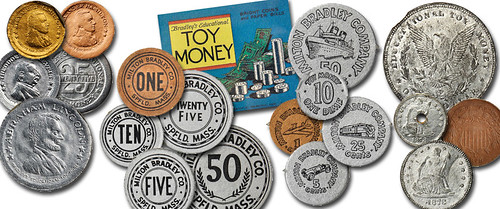
PREV ARTICLE
NEXT ARTICLE
FULL ISSUE
PREV FULL ISSUE
MORE ON MILTON BRADLEY’S EDUCATIONAL TOY MONEY
Stack's Bowers Numismatist Ben Orooji has published the second in a series of blog articles on toy money, a fun exonumia sideline.
-Editor

In my last exonumia article I discussed Milton Bradley's first three types of play money. In this edition I will describe the three more as well as one set of that is often incorrectly attributed to Milton Bradley. The fourth iteration of play money that Milton Bradley made was a significant departure from their previous printed styles in that thin foil was wrapped over a small sheet of cardboard, and then pressed with rectangular dies to bring up the design over multiple "coins" that could then be punched out of the sheet. Further, the number of denominations produced was vastly reduced, with the cent, nickel, dime, quarter and half dollar alone making the cut. The obverses depict the bust of a right facing U.S. president (Hamilton, Roosevelt, Jefferson, Washington or Lincoln respectively), with BRADLEY's EDUCATIONAL TOY MONEY below. The reverses display the numeric denomination at center and BRADLEY'S EDUCATIONAL / TOY MONEY around the periphery. The cent had either a copper or gold foil overlay, while all the other denominations had silver. Unfortunately, it seems there was difficulty in producing these consistently well, and the author has seen numerous examples with their designs in extremely low relief. The foil covering is also quite delicate, with some examples seen today missing the foil altogether! Perhaps for these reasons few of these sets were produced, as this is another type that is infrequently encountered. The box is quite simple with a two-tone red cover featuring stacks of coins and bills. The next type goes back to the more familiar printed standard with black ink on cardboard. These types are again produced in the cent through half dollar denominations and keep the proper diameters. No dates are present on the coins, and they bear the denomination on both sides, once in text and once with numerals over crossed stalks of grain. Around the peripheries of both sides is printed MILTON BRADLEY CO. / SPFLD. MASS. As seen previously, copper-colored cardboard is used for the cent, while the other denominations are printed on silver cardboard. The box bears an image similar to the previous set, but is presented in bright colors, and advertises the set as containing "Bright coins and paper bills." Though by no means common, this set is more common than the first, second and fourth types discussed in this series. The last type of play money produced by Milton Bradley is predictably the most frequently encountered and can be located without too much difficulty. The diameters are again true to the coins they imitate, and they are produced with black ink printed on copper and silver-colored cardboard. The denominations remain cent through half dollar. The obverse of each bears a different mode of transportation, the denomination below and MILTON BRADLEY COMPANY around the periphery. The reverse bears the denomination at center, TOY MONEY above, and the denomination in text below. Several different boxes exist for this set, but the most modern the author has seen bears a photograph of the actual bills and coins and the familiar Milton Bradley logo still in use today. The final set discussed is not part of the Milton Bradley series at all, but is often incorrectly grouped with it. It is also easily some of the rarest play money the author is aware of. Produced by the Walkley Company, this group of play money, like the first set discussed in this article, was also pressed with dies on cardboard covered with copper or silver foil. Unlike that set, however, these have their designs boldly defined, and the metallic overlay is generally rather secure. Each coin bears the date 1878 and quite closely resembles the coins of the era. The Indian cent has EDUCATIONAL TOY MONEY around the periphery on the obverse, whereas the other denominations: two-cent piece, Shield nickel, Liberty Seated dime, Liberty Seated quarter, Liberty Seated half dollar, and Morgan dollar all have the legend on the reverse. The dollar also bears PRO BONO PUBLICO at the top obverse periphery. Of particular interest, the author has encountered examples at several different times with the centers punched through, no doubt to ensure the coins did not pass as genuine currency. The concern of counterfeit coins would be laughable today, but in the early to mid-nineteenth century it was a genuine problem. Indeed, 50 cents could be close to a full day's wages, especially for a non-skilled worker. So prevalent was the problem, numerous counterfeit detection devices and scales were produced to assist the shopkeeper or banker, and collecting counterfeit half dollars is a popular specialty today, precisely because so many examples exist! To read the complete article, see:
To read the earlier E-Sylum article, see:
Wayne Homren, Editor The Numismatic Bibliomania Society is a non-profit organization promoting numismatic literature. See our web site at coinbooks.org. To submit items for publication in The E-Sylum, write to the Editor at this address: whomren@gmail.com To subscribe go to: https://my.binhost.com/lists/listinfo/esylum All Rights Reserved. NBS Home Page Contact the NBS webmaster 
|